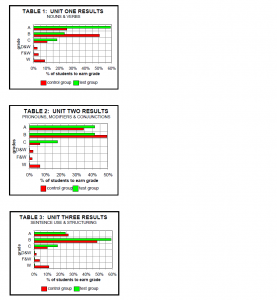Trent M. Pehrson and Dr. Cynthia Hallen, Linguistics
Creative language modeling (CLM) is a method of teaching linguistics principles to high school level students. In CLM, students learn about language principles by systematically designing an artificial language. The premise of CLM is that students can learn and retain language principles more readily when such principles are associated with creative experiences that give the student a personal stake in the learning process.
Initial testing of CLM took place at Alpine Life ad Learning Center, an alternative high school in Alpine School District. A test group and control group were selected. Both groups were taught the same curriculum and both groups were given the same test. Curriculum included sentence structure, parts of speech, basic grammar, capitalization and punctuation.
In the control group, teaching methods were primarily based on defining principles followed by exercises involving identification of defined principles in pre-constructed sentences. For example, after reading a definition of the term ‘pronoun’, students were asked to identify pronouns in a series of pre-constructed sentences. Students in the control group were also allowed to study curriculum in any order.
In the test group, curriculum was taught in order of succession. For instance, the concept ‘noun’ was taught before the concepts ‘plural noun’ or ‘possessive noun’. Teaching involved three points: defining principles, comparing the use of principles in non-English languages to those in English, and requiring the recitation of principles. Exercises included creating analogous principles in the artificial language and employing the artificial principles in spoken and written form.
Statistical analysis of the experiment can be seen in tables 1-3 below. Each of the three tables represents one unit of curriculum. A unit of curriculum is composed of weighted scores in four categories: attendance and participation, written exercises, an essay, and a test. The grade W was given to students who withdrew from a unit before beginning or completing it. The non-passing grades W&D and W&F were awarded to students who completed a unit but failed and withdrew rather than opting for remedial testing.
Results indicate that CLM did improve the performance of test subjects. In addition, none of the test subjects withdrew. This corresponds to the responses of subjects surveyed in both groups. Test subjects consistently claimed that they enjoyed the CLM experience and preferred it to former experiences in English. In contrast, control subjects frequently expressed that they disliked studying English and didn’t understand it.
Since this is the initial test of CLM, more study is needed. The next phase of the project will involve testing CLM in several conventional high schools. If future results confirm the benefits of CLM, the final phase will be to write and publish curriculum for high schools nationwide.

